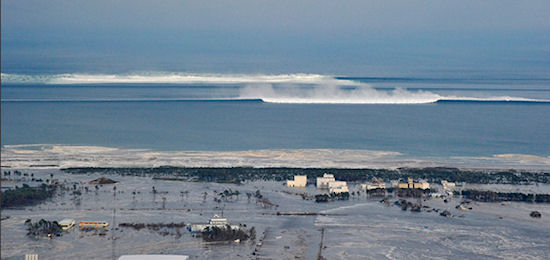In preparing to write my novel Tsunami, about a fictional undersea volcano on the verge of exploding and sending a monster tsunami smashing into California, I did a great deal of research into the world of natural disasters.
I leaned heavily on NOAA, USGS, NASA and dozens of library and university sources for my information. One thing became clear as I dug into the research: tsunamis are not self generating. They are always the product of some other natural event.
Tsunamis are triggered by disturbances on the ocean floor that displace water and upset the equilibrium of the surrounding ocean. Undersea earthquakes, landslides, and erupting volcanoes are the main causes. In deep water, the height of a tsunami wave may be less than 4 feet and hardly noticeable on the surface where normal swells are that large or larger, but the wave length, or the trough between waves in a tsunami train, can be 50 miles or more. Once a tsunami is propagated, the long wave travels at 500 to 600 miles per hour. As the wave nears land and the water shallows, the leading edge slows down and the trailing wave closes the gap and compresses the water into a wave that can build to a height of 100 feet or more as it sweeps ashore. The destructive power of a large tsunami hitting the shoreline is hard to imagine.
Recorded history's most destructive tsunami occurred on Dec. 26, 2004 in the Indian Ocean. A 9.1 magnitude undersea earthquake off the island of Sumatra created a massive tsunami. Waves 30 to 100 feet high struck Indonesia, Thailand, India, and eight other countries. 225,000 died.
Following the explosion of the Krakatau volcano in 1883, 130-foot waves wiped out whole villages along the coast of Sumatra, killing more than 36,000 people.
A tsunami can travel long distances without significant loss of energy. In 1960, a tsunami started by a 9.5 seafloor earthquake off Chile battered the Chilean coast and then travelled undetected thousands of miles across the Pacific Ocean, causing death and destruction in Hawaii, Japan, Alaska, and countries as far away as New Zealand.
In 1896, a deep submarine earthquake 200 miles east of Japan triggered a tsunami that sped unobserved toward land, quickly rising to 110 feet as it charged ashore. The fast-moving wave smashed into the village of Sanriku during a Shinto festival that had attracted thousands of people. The tsunami obliterated the village and killed 27,000. The wave had passed undetected under the keels of the fishing boats 20 miles offshore.
In Hilo, Hawaii, in 1946, the harbor, waterfront, and downtown area were destroyed by a 30-foot tsunami, and 159 people died.
Following the 1946 and 1960 tsunamis that devastated Hilo, Hawaii, Japan, and other countries around the Pacific Basin, 26 countries throughout the Pacific region collaborated in the installation of the Pacific Tsunami Warning System. Seafloor seismometers and tidal gauges were installed throughout the Pacific and connected to the System's operational headquarters in Ewa Beach, near Honolulu. Real time instrument readings locate the place and time of an undersea disturbance capable of starting a tsunami. Immediate warnings are issued to the areas of potential danger. The U.S. West Coast is protected by the West Coast and Alaska Tsunami Warning System headquartered in Palmer, Alaska. Unfortunately, no warning system was installed in the Indian Ocean prior to the December, 2004 tsunami that killed over 200,000 people. None of the countries bordering the Indian Ocean had advance warning of the approaching tsunami.
Even with a warning system in place, tsunamis can still take lives if triggered by undersea disturbances close to shore. In 1992 and 1993 over 2,000 people were killed by tsunamis in Nicaragua, Indonesia, and Japan. In 1998 a series of 50-foot waves caused by an undersea landslide only a few miles offshore washed over a small island near Papua, New Guinea, denuding the island and taking 2,200 lives. The first wave struck within minutes of the undersea event, giving the islanders no chance to prepare.
A tsunami is usually made up of more than one wave. A train of two, three, or four waves can strike land at intervals of 10 to 30 minutes or longer. The first wave is usually not the largest. The second or third wave is often the biggest and most destructive.
Very little is left standing after a large tsunami sweeps ashore. The wave’s power smashes buildings, uproots trees, and sucks everything back out to sea when it recedes. The scene is one of complete devastation. If you live near the ocean, take tsunami warnings seriously. Head inland as directed by local authorities. Do not go to the beach to see what a tsunami looks like. By the time you find out, it will be too late.




